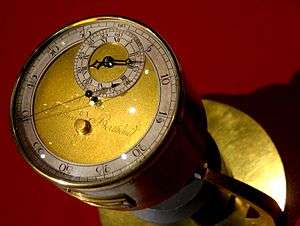International Museum of Horology
| Musée International d'Horlogerie | |
 | |
 Location within Switzerland | |
| Established | 1974 |
|---|---|
| Location | La Chaux-de-Fonds, Switzerland |
| Coordinates | 47°06′03″N 6°49′48″E / 47.1008°N 6.8301°E |
| Website | http://www.mih.ch |
The International Museum of Horology, French: Musée international d'horlogerie (MIH), is a museum in La Chaux-de-Fonds, Switzerland, dedicated to horology, which is the study of time, timekeeping and timekeeping devices (primarily clocks and watches). The museum is owned and operated by the city of La Chaux-de-Fonds.




Historically the city of La Chaux-de-Fonds is considered one of the focal points of the Swiss watchmaking industries and the home of one of the country's famous watchmaking schools. The museum grew out of the study collection of the school, and is considered today among the broadest and most comprehensive watch and clock museums of the world. In addition to constantly changing temporary exhibits the museum features permanent displays from its vast collection of watches and clocks throughout history. While the collection is obviously strong on Swiss pieces it covers most places where timekeepers were made in any quantity.
To just get a general overview of the holdings will take at least an hour, a highlights tour will be half a day, but it is easy to spend more time there. Visitors who make a trip to La Chaux-de-Fonds to see MIH will typically also want to visit the Musée d'Horlogerie du Locle a smaller horological museum in the neighboring town of Le Locle, which complements MIH.
Both Le Locle and its geographical twin town La Chaux-de-Fonds have now been recognised as an UNESCO World Heritage Site, for their horological and related cultural past.
History
In 1865 the Watchmaking School of La Chaux-de-Fonds had the idea of putting together a collection of old clocks. This resulted, in 1902, in the opening of a small museum in the same building as the school. The collection gradually grew and the museum was enlarged three times, in 1907, 1952 and 1967.
It finally became clear that the premises were no longer suitable for a permanent and functional display of the whole collection. The Committee of the Museum therefore suggested to the Municipality of La Chaux-de-Fonds that a foundation should be set up with the purpose of promoting the construction of a new building. Opened in 1974 under the name of Musée international d'horlogerie, this was characterized by a conception and techniques in the avant-garde of architecture and museography. Three decades later its construction is as fascinating as its exhibits.
Collection
Major highlights of the exhibits include:
- One of the few existing full-size replicas of Giovanni de'Dondi's Astrarium, the fabled clockwork-driven 14th-century mechanism showing the movement of the sun, moon and the planets.
- A comprehensive exhibition on the history and chronology of the "Pendule neuchâteloise"
- Several outstanding clocks by major master clockmakers, including Abraham-Louis Breguet, Antide Janvier, Julien Le Roy, Robin etc.
- One of the pioneering early weight-driven marine chronometers by Ferdinand Berthoud
- A unparalleled collection of antique machinery to make parts and components for watches
- A superb musical organ clock by Pierre Jaquet-Droz
- A large collection of antique tower-clock movements covering several centuries of technological innovation
- A significant collection of precision pendulum clocks, including examples by Strasser & Rhode, Sigmund Riefler, Zenith and F.M. Fedchenko
- Several automata
- A "Proletarian" watch by Georges Frederic Roskopf
- A monumental fresco, The Conquest of Time, painted by Hans Erni in 1958 for the Swiss Pavilion at the Universal Exhibition, Brussels
Outside of the museum, on its roof, is a major 20th-century carillon clock.
In addition to its permanent exhibitions, MIH regularly produces special temporary exhibitions on various aspects of timekeeping or time.
Affiliated organizations
- Associated with the museum is a first rate conservation workshop which conserves and restores their own pieces as well as doing work for other horological museums.
- The library of the museum (technically part of the City Library of La Chaux-de-Fonds) is considered the most comprehensive specialized horological library in Switzerland, and its holdings are cataloged within the RERO union catalog (www.rero.ch).
- Also affiliated is "L'Institut l'homme et le temps" a research and publishing arm that studies the role of time and timekeeping instruments in society.
See also
References
- Baillod Gil, "The beating heart of worldwide horology", in watch around, n.012, automn 2011-winter 2012, pp. 70-73
- Bosshart, Nicole, "International Museum of Horology – La Chaux-de-Fonds", in BUJARD Jacques; TISSOT Laurent (2008), The Territory of Neuchâtel and its Horological Heritage. Chézard-Saint-Martin: Editions de la Chatière, pp. 351-354, ISBN 978-2-940239-16-0.
- Mercier, Francois; Cardinale, Catherine (1993). Museums of Horology - La Chaux-de-Fons - Le Locle. Zurich: Swiss Institute of Art Research. p. 128. ISBN 3-908184-33-9.
- de Limoge, Andre (1974). Collections du musee internationale d'horlogerie, La Chaux-de-Fonds, Suisse - Une selection parmi 3100 objects. La Chaux-de-Fonds, Suisse: musee internationale d'horlogerie. p. 151.
- Cardinal, Catherine; Piguet, Jean Michel (2002). Catalog of Selected Pieces - Musee Internationale d'Horlogerie. La Chaux-de-Fonds, Suisse: Musee internationale d'horlogerie. p. 384. ISBN 2-940088-10-1.
External links
| Wikimedia Commons has media related to International Museum of Horology. |
Coordinates: 47°06′03″N 6°49′48″E / 47.1008°N 6.8301°E